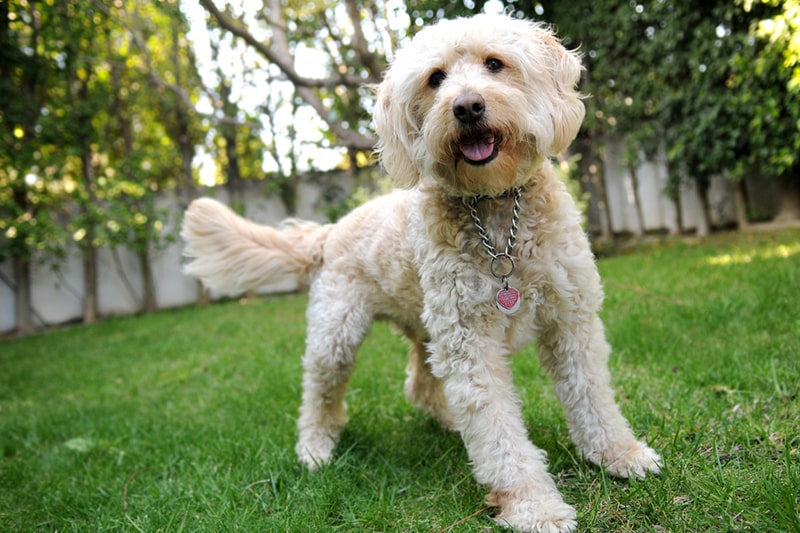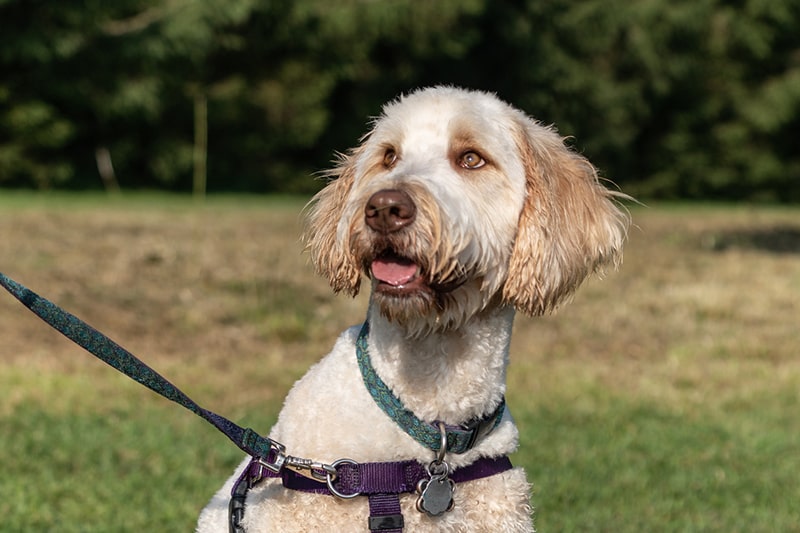All About Alaskan Malamutes
Alaskan Malamutes bring the brains and brawn to the table—as well as a lively personality. It’s easy to see why they have been around for thousands of years.
A mix between a Labrador Retriever and a Poodle, the Labradoodle is a fairly new breed of dog. Described as spunky, friendly, and smart, Labradoodles can be a great choice for first-time dog parents and families with children.
As with any dog, it is important to do your research before adopting and to become familiar with the breed you will be bringing into your home. Labradoodles can seamlessly become your next family member, but it’s helpful to read up on their common traits ahead of time.
Although some people suggest that Labradoodles made an appearance in America in the 1960s, the original creation date for these dogs is marked as 1989. Wally Conron, who led the breeding program for the Royal Guide Dogs Association of Australia, was tasked with creating a service dog for people with a dog allergy.
After several attempts, Conron came across a mix that seemed more than ideal. Between the Poodle’s intelligence and low dander count and the Labrador Retrievers friendly and trainable behaviors, Conron was able to create the exact type of dog for which the Royal Guide Dog Association of Australia was hoping.
As with many of the other Doodle types, the Labradoodle was slow to gain attention. But, by the early 2000s, Americans began realizing how wonderful these dogs are, and their popularity skyrocketed in just a few years.

Quickly becoming one of the most popular types of dogs in America, you may now be considering adopting your own Doodle. While trying to decide on whether a Labradoodle will be a good fit for your lifestyle, you may discover that you have many questions about the breed. Among other pet parents who are considering adopting a new fuzzy family member, the most common questions include:
1. Do Labradoodles Shed?
Most Labradoodles shed very little to none at all. However, not every Labradoodle is created the same, so their coat type will vary—as will the amount that they shed.
Labradoodles can have a variety of textures in their hair, including wavy, curly, smooth, and wiry. They can also be found in a wide range of colors, which include gold, apricot, caramel, black, red, brown, cream, and silver. Doodles can even have multi-colored coats in a brindle, phantom, or sable pattern.
2. How Big Do Labradoodles Get?
A Labradoodle’s size will deviate from dog to dog—this will be determined by the size of the Poodle parent. Poodles come in three sizes, which means that Doodles also come in three sizes—Standard, Medium, and Miniature.
Standard Doodles are 20-24 inches in height and 50-65 pounds in weight. Medium Doodles are 17-20 inches in height and weigh 30-45 pounds. Miniature Doodles are 14-16 inches in height and 15-25 in weight.
3. How Long Do Labradoodles Live?
Labradoodles live on average 12-16 years. This number is affected by your dog’s diet and exercise plan, size, and whether they have any medical issues.
4. What Are Labradoodles Like?
Personality-wise, Labradoodles are outgoing and friendly, so they are always looking at ways to make new pals. Because of this natural instinct to meet new people and animals, it is important to always have your Doodle on a leash when outside, or to have your pup in a fenced-in area.
5. Are Labradoodles Good Family Dogs?
Because of their demeanor, Labradoodles are a great choice if you are a multi-pet family or if you have children. It is important to note that if your children are younger, they should be supervised when interacting with your Labradoodle.
Younger kids have a tendency to lie or climb on dogs or accidentally pull their ears or tail, which could result in unwanted behavior from your dog. Not to mention, Labradoodles have a tendency to get overly excited when playing, which can lead to them knocking over your young child—Doodles just have a lot of love to give.
While this breed is an excellent choice for many families, it is essential to do your research on various dog breeds when looking to adopt.

The grooming needs of Labradoodles will vary from dog to dog, based on their coat type and length. On average, most Doodles require a weekly or biweekly brushing.
If you are familiar with Labrador Retrievers, then you know all too well how their hair tends to shed on every surface and piece of clothing in sight. Fortunately, when a Doodle’s fur comes loose, it doesn’t immediately fall out. Instead, the loose bits will become tangled with the rest of their coif and remain on the dog’s body. Because so much hair is then just sitting on the dog, Doodles can quite easily develop mats. Consistent brushings will take out the loose hair and help keep pesky clumps from developing.
Extra care should be taken with your Doodle’s floppy ears since they are prone to getting ear infections. One of the easiest habits to begin early with your dog is to give their ears a weekly check, making sure they’re not red or giving off a bad odor. It is equally as important to dry and clean their ears after they go swimming.
All other grooming needs for the Labradoodle follows suit with the majority of other breeds—Labradoodles are relatively low maintenance in the grooming department. Besides brushing, bathing, and checking the ears, your Doodle’s nails should be trimmed when you can hear them clicking on the floor, and their teeth should be brushed a few times a week.
A good rule of thumb when it comes to puppies (and dogs of any age) is that a bored puppy will be a destructive puppy, and Labradoodles are no exception.
Many Doodle owners are not aware ahead of time on just how much energy a Doodle has and how much exercise they require. Typically a 30-minute walk in the morning and at night is a sufficient amount for these pooches. If you have a fenced-in yard, you can just as easily let your Doodle loose to run at their desire.
Although they are a medium to high energy dog, Labradoodles can quickly become acclimated to city living as they can to rural living. While Standard Doodles may not be ideal for apartments, the Medium and Miniature Doodles may be the perfect choice for a new roommate—just don’t forget to check your apartment’s guidelines on dogs.

Due to their eagerness to learn, Labradoodles thrive with beginning training and socialization when they are just a puppy. By starting training at a young age, you will be able to nip bad behaviors in the bud, and you and your pup can begin building a trusting relationship. Even if you adopt an older dog, it is never too late to begin training. No matter what some people may say, you can teach an old dog new tricks!
Some useful commands to begin with include sit, stay, down, drop it, heel and off. Of course, one of the most important items to work on with your new puppy is house training.
Along with house training your puppy, crate training may be the next most beneficial item to work on. Having a pet that is crate trained can be beneficial for both you and your dog. For instance, when you leave the house for an extended amount of time and your pup is left unattended, an unknown number of incidents can occur—anything from shoes being chewed on to potty accidents in the house.
By training your dog to be comfortable with being crated, you can have ease of mind when you are away that your dog will be safe and your home will remain in one piece. Not to mention, after becoming crate trained, dogs will oftentimes view their crate as a safe place where they can retreat to when they want a nap, are scared from a storm, or need a break from their fellow canine brother or sister.
When it comes to socialization, exposing your dog to various social settings is extremely beneficial. Not only will your dog become better acclimated to being around other dogs, but they will become more relaxed with meeting new people and being around new experiences. Anything from walks around the neighborhood, visits to the local park, or trips to the beach can help expand your dog’s socialization opportunities.
According to our claims data*, the top 5 health issues that affect Labradoodles are:
Due to Labradoodles being a mix dog, your Doodle could be more susceptible to Poodle health issues such as, hip dysplasia, progressive retinal atrophy (PRA), Von Willebrand’s disease, and Addison’s disease or Labrador health issues such as hip dysplasia or PRA. However, since it is not easy to predict genetics among mix-breed dogs, it is equally as likely that your Doodle will not inherit any of these conditions at all.
*Internal Claims Data, 2019
The information presented in this article is for educational and informational purposes only and does not constitute or substitute for the advice of your veterinarian.